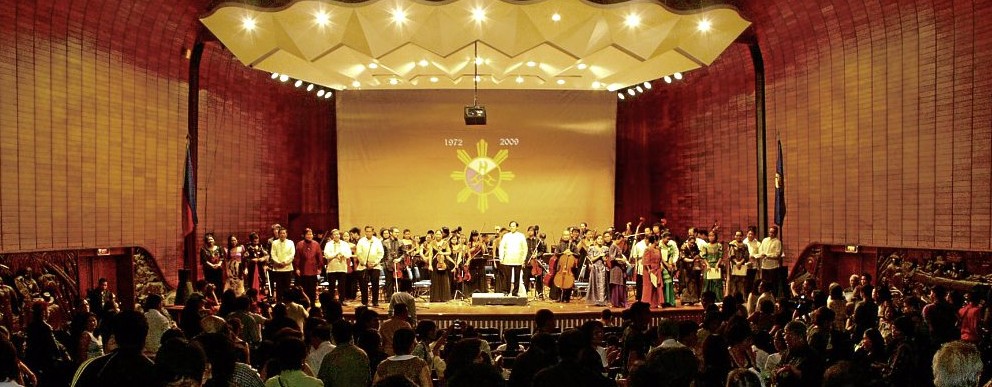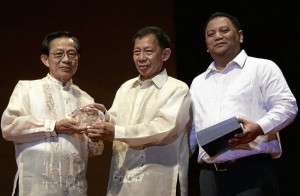

The birth centenary of National Artist for Music Felipe Padilla de Leon Sr., a great pillar in Philippine music, was recently celebrated at Philamlife Theater. The National Commission for Culture and the Arts (NCCA) led the celebration through a concert, indeed, a fitting homage, featuring his compositions written in various forms.
Never had Philamlife Theater been filled to capacity before this concert. Both the young and the old, musicians and nonmusicians, the culturati and plain laymen, came to pay tribute to the man whose music had touched their hearts.
The country’s top classical artists pooled their talents in honor of the man who did not allow poverty to stop him from becoming a musical luminary, championing Filipino cultural identity from the difficult time of the country’s quest for nationhood in the 1930s, through the harrowing years of the Japanese occupation, to the postwar period and onward, until his death in 1992.
For this legacy, the country honored him in 1997 with the highest award, the National Artist Award, which cited him as the “epitome of a people’s musician.”
On top of his being a composer, he was also an educator, conductor, columnist and radio host, cultural administrator and leader. He was a cultural visionary who relentlessly advocated culture as a staunch ally of national development, through the musical arts.
Seminal works
Featured artists in the concert were the Manila Symphony Orchestra (MSO), with Arturo Molina conducting; pianists Raul Sunico and Augusto Espino; violinist Alfonso “Coke” Bolipata; flutist Santiago Yangco; sopranos Aileen Espinosa-Cura, Joy Abalon-Tamayo, Geraldine Flores; tenor Conrado C. Ong III; and the Kasarinlan Philippine Ensemble with Justice Magdangal M. de Leon conducting. Roderick Bayonito emceed the program through a voiceover.
The program, titled “Sa Daigdig ng Musika ni Felipe Padilla de Leon,” consisted of art songs, operatic arias and duets from his opera “Noli Me Tangere” (1957); symphonic works, piano works, chamber works for violin and flute, and choral works.
The concert was preceded with an audiovisual presentation, “The Legacy of Felipe P. de Leon,” aimed to refresh the audience’s memory of the maestro’s solid sense of Filipinism.
Being one of a rare breed of Filipino composers who glorified the nationalist tradition, he argued that the folk song, because it was the natural and spontaneous expression of a people’s way of life, was the soul of national music. Musical compositions therefore, to be relevant, must be expressed in a language understood by the people.
This language is rooted in their folk songs, which embody and reflect the people’s character. This assures understanding and ennobles the people, as the folk song becomes a hallmark of a people’s identity.
Nationalist writings
The maestro stressed this point in both his writings, and in public as well as private talks. I had the privilege to make several visits to his residence on Boston Street in Cubao, Quezon City, during which he would share highlights of his life. He also gave me printed copies of his compositions for piano, voice and choir, complete with dedication, as well as his writings, which he allowed me to duplicate, including his columns which had been bound into a single volume.

His wife, whom we fondly called Nanay, the late Iluminada Mendoza de Leon, a concert pianist and a great sight-reader at that, would always be with us. She would gladly go to the piano and play the maestro’s works whenever he needed to emphasize a point.
I also had the privilege to be invited a couple of times, as conductor of a choir, to guest on his radio program on DZRM in the ’70s, where my choir sang nationalistic songs he had penned.
His vision is inscribed in one of his speeches dated 1966, “Culture: A Solution to Our Problem,” in which he potently argued that culture was a staunch partner of development. While economics, he said, serves only as a veneer to “cover up the tragedies of a people’s life,” culture “provides the inward strength, hardens our responses in the face of a thousand economic failures.” A nation that is culturally starved, he stressed, crumbles, bringing down even the people’s own identity.
Once our cultural undertaking finds fulfillment, “we will have succeeded in inducing growth of our moral and spiritual life in creating a perfect atmosphere where all the excesses of our national life can blossom into one beautiful song—the song of unity, of progress, of self-determination,” he said.
Pasambap
Much earlier, as a student in composition and conducting at the UP College of Music during the Commonwealth period, he had already been proclaiming nationalism as a musical idiom, a view that he articulated in his column in the Philippine Collegian. He said the country’s leading composers and musicians were “leaving no stone unturned in creating a music that is distinctly Philippine,” inspired by the “vast treasures” of the country’s folk songs.
As cultural leader and administrator, De Leon espoused the professionalization of the bands when he organized Pambansang Samahan ng Mga Banda sa Pilipinas (Pasambap). Rather than fostering petty rivalries, he advocated through Pasambap the bands’ professionalization, seeking their cooperation in the task of promoting band music.
Lest one forgets, he was a band member, playing the horn in Banda Pagkakaisa of his beloved town, Peñaranda, Nueva Ecija. Soon he developed adeptness in playing the trombone. More than being an instrument player, he would soon write arrangements for the band.
Indeed, the band served as the maestro’s laboratory to hone his musical talent, just like most of our other local composers who also initially developed their skills through the experience of playing in a band.
Filscap
It was largely through the maestro’s initiative that the Filipino Society of Composers, Authors and Publishers (Filscap) was organized.
In recognition of this valuable contribution, Filscap presented him with a posthumous award, received by the maestro’s sons Tagumpay and Felipe Jr. The former is an engineer and violinist based abroad; the latter a retired UP professor who is now chair of the NCCA.
Maestro was an indefatigable writer of hymns and marches. In fact, the entire nation had sung his marches and anthems penned under the bayonet during the Japanese period and during martial law.
“Tindig, Aking Inang Bayan,” composed upon the behest of the Japanese during the Pacific War, contained strains of the national anthem, a subtle way of the maestro’s expression of his nationalist sentiment. Because it sounded Filipino, the guerrillas fighting the Japanese liked and even sang it.
His march “May Bagong Silang” contains a passage that similarly echoes the national anthem. Another song, “Ang Bayan Ko’y May Dangal, Puri’t Kagitingan,” conveys the noble sentiments of the folk song “Inday sa Balitaw,” expressed in a haunting hymn.
In December, all throughout the country, his Christmas songs “Pasko Na Naman” and “Noche Buena” will again be sung by both amateur and professional singers as well as choirs. These songs have ceased to be Maestro’s compositions—they have become national treasures owned by the people.
Musical language
It is because Maestro came from the people that he understood their musical language, said one of his daughters, Marilag, a pianist, speaking in Filipino, in her short remarks made on behalf of the family during the concert tribute.
Maestro, she said, was a loving father who made music a meaningful language in their home. She thanked the NCCA, the performers and the audience paying homage to her father.
Indeed, Maestro is remembered not only as a loving father but also as a composer who fostered a deep sense of patriotism, a burning loyalty to the country, which he glorified through his compositions.








































